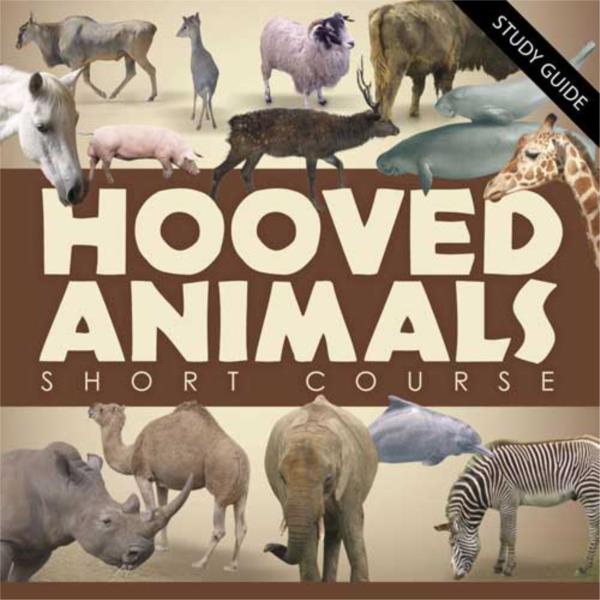Home > Short Courses
Short Course- Hooved Animals
Sneak Peek
Short Course Hooved Animals
Self Paced 20-hour course to help you understand more about ungulates.
This course gives you a broad and solid foundation, to
understand what a hooved animal is, it’s natural distribution, distinguishing
physical characteristics, digestion, behaviour, breeding and more.
It is a course that some will use for professional
development and others to enhance their opportunities for work they are hoping
to move into. It may help fill in gaps in your knowledge; or refresh fading
experience.
We have designed tis course to provide a broad foundation
for understanding ungulate (hooved) mammals; and in doing so, underpin and
support your capacity to grow that knowledge through experience and further
study, whether formal or informal.
Our 20 hour courses are self paced and will help you understand a topic
in a short amount of time. You can work through the course when you
like- test yourself with mini-tests along the way. There are extra case
studies or research you can undertake if you would really like to get
into the topic. Once you have completed the lessons and self assessment
tasks, there is a final exam undertaken online- you can then download
your personalised certificate.
Course Content
This course has five lessons. Each lesson has a corresponding online self-assessment test.
Lesson 1 Introduction – Over view of Ungulates
- Introduction
- Digestion
- Behaviour
- The Ungulate Brain and Behaviour
- Grandorder: Ungulata
Lesson 2 ARTIODACTYLS: Even-Toe d Ungulates
- Introduction
- A Note on Taxonomy
- Habitat and Locomotion
- Physical Characteristics
- Digestion
- Physiology
- Psychology and Behaviour
- Significance to Man
- Subgroups
- Suborder: Suiformes
- 1) Tayassuidae
- 2) Suidae
- 3) Hippopotamidae
- Suborder: Tylopoda
- Suborder: Ruminantia
- 1) Tragulidae
- 2) Giraffidae
- 3) Cervidae
- 4) Moschidae
- 5) Antilocapridae
- 6) Bovidae
- What are Cattle?
- Cattle Biology
- Cattle Behaviour
- What are Goats?
- Biological Terminology
- Goat Psychology and Social Structure
- Sheep
Lesson 3 PERISSODACTYLS
- Introduction
- Habitat and Distribution
- Physical Characteristics and Physiology
- Digestion
- Reproduction
- Behaviour
- Significance to Man
- Subgroups
- Ceratomorpha
- Hippomorpha
- Hippomorpha
- Equidae
- Social Behaviour
- Harem Breeding Groups
- Territorial Breeding Groups
- Domesticated Horses
- Asses
- Zebras
- Ceratomorpha
- Tapiridae
- Rhinocerotidae
- Physical Characteristics
- Reproductive Behaviour
- Diet and Feeding
- Shoeing the horse
Lesson 4 Aquatic Ungulates
- Introduction
- Order Cetacea
- Evolution
- Habitat and Distribution
- Physical Characteristics and Physiology
- Digestion
- Reproduction
- Behaviour
- Echolocation
- Significance to Man
- order: Cetacea
- 1) Suborder Mysticeti (Baleen Whales)
- 2) Suborder Odontoceti (Toothed Cetaceans)
- Suborder: Mysticeti (Baleen Whales)
- Family: Balaenidae
- Physical Characteristics
- Diet and Feeding
- Reproductive Behaviour
- Habitat
- Family: Balaenopteridae
- a) Subfamily Megaptera
- Physical Characteristics
- Diet and Feeding
- Reproductive Behaviours
- Habitat
- b) Subfamily Balaenopterinae
- Physical Characteristics
- Diet and Feeding
- Reproductive Behaviour
- Habitat
- Family: Neobalaenidae
- Family: Eschrichtiidae
- Physical Characteristics
- Reproduction and Behaviour
- Diet and Feeding
- Habitat
- Suborder: Odontoceti (Toothed Cetaceans)
- Family: Delphinidae
- Physical Characteristics
- DOLPHINS
- 1) Genus Cephalorhynchus
- Physical Characteristics
- Reproduction and Behaviour
- Diet and Feeding
- Habitat
- 2) Genus Delphinus
- Physical Characteristics
- Reproduction and Behaviour
- Diet and Feeding
- Habitat
- 3) Genus Grampus
- Physical Characteristics
- Reproduction and Behaviour
- Habitat
- 4) Genus Lissodelphis
- Physical Characteristics
- Reproduction and Behaviour
- Diet and Feeding
- Habitat
- 5) Genus Sousa
- Physical Characteristics
- Reproduction and Behaviour
- Diet and Feeding
- Habitat
- 6) Genus Tursiops
- Physical Characteristics
- Reproduction and Behaviour
- Diet and Feeding
- Habitat
- Whales
- 1) Genus Feresa
- 2) Genus Orcinus
- 3) Genus Globicephala
- 4) Genus Peponcephala
- 5) Genus Pseudorca
- Family: Physeteridae
- Family/Subfamily: Kogiidae
- Family: Ziphiidae
- Family: Platanistidae
- Family: Iniidae
- Family: Lipotidae
- Family: Pontoporiidae
- Family: Monodontidae
- Family: Phocoenidae
- Order: Sirenia
- 1) Dugongidae
- Physical Characteristics
- Reproduction and Behaviour
- Diet and Feeding
- Habitat
- 2) Trichechidae
Lesson 5 Other Ungulates
- Order: Proboscidea
- Habitat and Distribution
- Physical Characteristics and Physiology
- Digestion
- Reproduction
- Behaviour
- Significance to Man
- Order: Tubulidentata
- Habitat and Distribution
- Physical Characteristics and Physiology
- Digestion
- Reproduction
- Behaviour
- Significance to Man
- Order: Hyracoidea
- Habitat and Distribution
- Physical Characteristics and Physiology
- Digestion
- Reproduction
- Behaviour
- Significance to Man
- Physical Characteristics
- Behaviour and Reproduction
How does this course work?
You can enrol at any time.
Once you have paid for the course, you will be able to start straight away.
Study when and where you like. Work through at your own pace.
You can download your study-guide to your smart phone, tablet or laptop to read offline.
There are automated self-assessment tests you can complete at the end of each lesson. You can attempt these as many times as you wish and each time, upon completion, you can see your results. You will need internet access to complete the self assessment tests.
At the end of the course, you are presented with a large assessment which can be attempted online, anywhere, anytime. If you achieve a 60% pass in the exam; you immediately receive a downloadable certificate of completion with your name on it. If you do not achieve a 60% pass rate, you can contact us to re-sit your exam ( email- [email protected] )
Contact us at anytime if you have any issues with the course - [email protected]
Write a Review
Please ensure you are logged in to write a review.
Short Course- Hooved Animals

£100.00
In stock